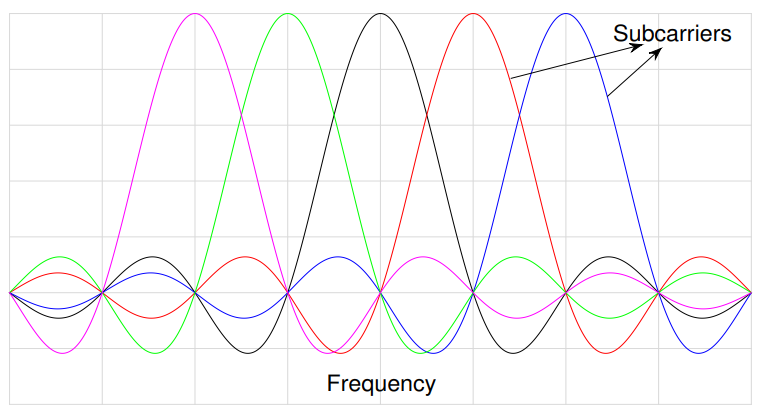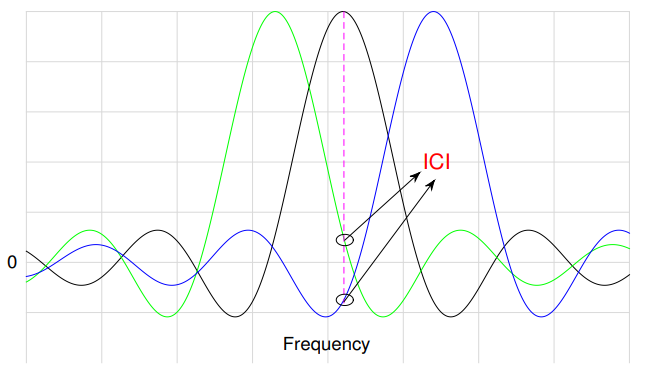OFDM Transmitter And Reciver Using QPSK
Orthogonal Frequency Division Multiplexing
When a signal with high bandwidth traverses through a medium, it
tends to disperse more compared to a signal with lower bandwidth.
A high-bandwidth signal comprises a wide range of frequency
components. Each frequency component may interact differently with
the transmission medium due to factors such as attenuation,
dispersion, and distortion. OFDM combats the high-bandwidth
frequency selective channel by dividing the original signal into
multiple orthogonal multiplexed narrowband signals. In this way it,
overcomes the inter-symbol interferences (ISI) issue.

OFDM converts frequency-selective channel to multiple (M) frequency-flat channels.
Block Diagram:

Fig: OFDM
In OFDM, modulation and demodulation are performed using IFFT and
FFT.
At transmitter side:

At receiver side:

In OFDM, Information is signalled in the frequency domain. It is
based on 1-D transform in frequency domain (IFFT/FFT). Orthogonality
among the subcarriers is the key.

Effect of high Doppler in OFDM
In presence of high Doppler, subcarriers lose orthogonality. This results in inter-carrier interference (ICI).

Causes severe degradation in bit error performance for high Doppler
(error floors). Channel estimation and equalization in high Doppler
channels is difficult.
To avoid ISI while transmitting many parallel low bandwidth signals,
the individual subcarriers must be orthogonal to each other.
Avoiding ISI by transmitting many orthogonal low bandwidth
subcarriers motivates OFDM. An OFDM modulator converts a high-rate
serial stream of symbols into many parallel low-rate streams. Each
orthogonal low-rate stream encounters a relatively flat channel with
minimal ISI, and can be easily equalized.
To demonstrate, consider a pulse of duration Tsym=0.25 sec, a symbol
data rate Rsym=1 / Tsym=8 Hz, and additional pulses translated in
frequency by Rsym, 2Rsym, and 3Rsym. The frequency-translated pulses
are called subcarriers.
Rsym is the symbol rate of each of the low-rate QAM streams
Tsym=1 / Rsym (Tsym is the pulse duration of each
An OFDM modulator sums all these subcarriers together to form its
output signal. Here, the subcarriers are baseband modulated using
the QAM-method. Mathematically, the sampled modulator output signal
s(k) is given by

Where, am,n is QAM symbol stream and it is a QAM-modulated symbol of
the mth subcarrier in the nth OFDM time symbol
‘k’ indicates kth position in a input symbol
N is the number of subcarriers
OFDM Transmitter

1. Data Encoding:Convert the
input data stream into symbols suitable for transmission (e.g.,
using QAM, PSK, or other modulation schemes).
2. Serial-to-Parallel Conversion:
Group the symbols into blocks, and then convert these serially
arranged symbols into parallel data streams, one for each
subcarrier.
3. IFFT (Inverse Fast Fourier Transform):
Apply the IFFT algorithm to convert the time-domain parallel data
streams into frequency-domain OFDM symbols. The IFFT operation
converts the data from the frequency domain to the time domain.
4. Cyclic Prefix Addition: Add a
cyclic prefix to each OFDM symbol to mitigate the effects of
multipath delay spread. The cyclic prefix is a copy of the end part
of the OFDM symbol that is appended at its beginning.
5. Digital-to-Analog Conversion:
Convert the time-domain OFDM symbols into analog signals.
6. Upconversion and Transmission:
Upconvert the analog OFDM signal to the desired carrier frequency
and transmit it over the wireless channel.
OFDM Receiver

1. Signal Reception:Receive the
transmitted OFDM signal after it has traveled through the wireless
channel.
2. Downconversion:Downconvert the
received signal to baseband or an intermediate frequency.
3. Analog-to-Digital Conversion:
: Convert the analog signal into a digital form suitable for
processing.
4. Cyclic Prefix Removal: Remove
the cyclic prefix from each OFDM symbol.
5. FFT (Fast Fourier Transform):
Apply the FFT algorithm to convert the time-domain OFDM symbols back
into the frequency domain. The FFT operation recovers the original
frequency-domain OFDM symbols.
6. Parallel-to-Serial Conversion:
Convert the frequency-domain symbols back into a serial data stream.
7. Data Demodulation: :
Demodulate the received symbols to recover the original data stream.
8. Channel Equalization: Apply
channel equalization techniques to mitigate the effects of channel
impairments, such as frequency-selective fading.
9. Data Decoding: Decode the
received symbols to obtain the original transmitted data.
